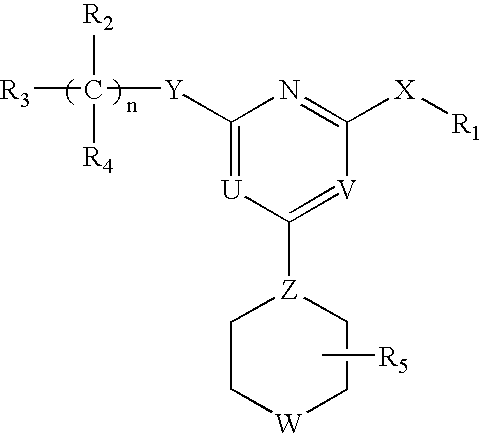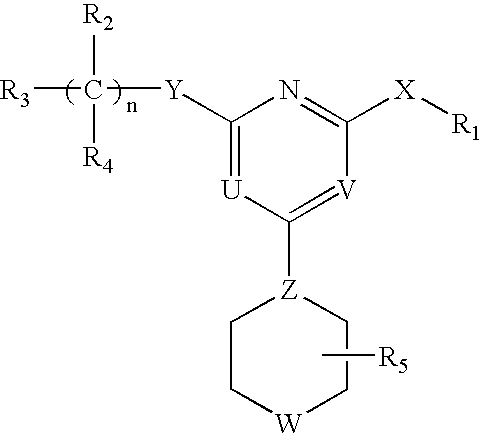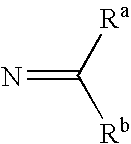Heterocyclic Compounds For Preventing And Treating Disorders Associated With Excessive Bone Loss
a technology of heterocyclic compounds and disorders, applied in heterocyclic compound active ingredients, biocide, drug compositions, etc., can solve the problems of low bone mass, increased risk of fracture, and increased risk of osteoporosis for patients, and achieve the effect of inhibiting osteoclast formation
- Summary
- Abstract
- Description
- Claims
- Application Information
AI Technical Summary
Benefits of technology
Problems solved by technology
Method used
Image
Examples
specific embodiments
[0062]The invention relates to compounds and pharmaceutical compositions that are particularly useful for treating or preventing disorders associated with excessive bone loss (including, without limitation, periodontal disease, non-malignant bone disorders (such as osteoporosis, Paget's disease of bone, osteogenesis imperfecta, fibrous dysplasia, and primary hyperparathyroidism) estrogen deficiency, inflammatory bone loss, bone malignancy, arthritis, osteopetrosis, and certain cancer-related disorders (such as hypercalcemia of malignancy (HCM), osteolytic bone lesions of Multiple myeloma and osteolytic bone metastases of breast cancer and other metastatic cancers). The invention further encompasses methods for inhibiting osteoclast formation in vitro or in vivo, comprising contacting a pre-osteoclast cell (e.g., a cell capable of forming an osteoclast cell upon differentiation and / or fusion) with an effective amount of a compound of formulas (I), (I′), and (I″) or a pharmaceutically...
example 1
Preparation of Compound 1: N-{2-[3-(3,4-dimethoxy-phenyl)-propyl]-6-morpholin-4-yl-pyrimidin-4-yl}-N′-(1H-indol-3-ylmethylene)-hydrazine
[0248]To a solution of 3-(3,4-dimethoxyphenyl)-propyl iodide (1.224 g, 4.0 mmol) in 20 mL dry THF, highly active zinc (suspension in THF, Rieke metal from Aldrich, 5.2 mL 0.05 g / mL, 4.0 mmol) was added to obtain a mixture. The mixture was stirred at room temperature overnight. 2,4-dichloro-6-morpholinopyrimidine (0.932 g, 4.0 mmol) and trans-benzyl-(chloro)-bis-(triphenylphosphine)palladium(II) (0.03 g, 0.04 mmol) were added to the mixture, and stirred at 60° C. for 2 days. After routine workup, 4-chloro-2-[3-(3,4-dimethoxyphenyl)propyl]-6-morpholinopyrimidine (0.34 g, 0.90 mmol, 22.4%) was separated from 2-chloro-4-[3-(3,4-dimethoxyphenyl)propyl]-6-morpholinopyrimidine (0.45 g, 1.19 mmol, 30%) by flash chromatography purification.
[0249]1H NMR (300 MHz, CDCl3), δ (ppm): 6.70-6.80 (m, 3H); 6.32 (s, 1H); 3.87 (s, 3H); 3.85 (s, 3H); 3.73-3.78 (m, 4H); ...
example 2
Preparation of Compound 2: N-(2-n-butoxy-6-morpholin-4-yl-pyrimidin-4-yl)-N′-(1H-indol-3-ylmethylene)-hydrazine
[0257]To a solution of 2,4,6-trichloro pyrimidine (25 g, 136 mmol) in CH2Cl2 (500 mL) at −78° C., morpholine (11.89 mL, 136 mmol) was slowly added, followed by DIPEA (25 mL, 143 mmol). The obtained reaction mixture was stirred at −78° C. for 5 h, and then warmed up to room temperature. The reaction mixture was washed with water. The obtained organic phase was dried over Na2SO4. The solvent was removed under reduced pressure. The crued residue, 2,4-Dichloro-6-(morpholin-4-yl)pyrimidine, was recrystallized from EtOAc to give white crystals (24.7 g, 77%) 15 g.
[0258]1H NMR (300 MHz, CDCl3), δ (ppm): 6.40 (s, 1H); and 4.0-3.5 (m, 8H). MS (ESI): m / z 234.0 (M+H).
[0259]To a solution of n-butanol (0.633 g, 8.54 mmol) in anhydrous DMF (50 mL) at 0° C. under the N2, NaH (0.307 g, 12.8 mmol) was added quickly. The obtained suspension was stirred for 0.5 h at 0° C. 2,4-Dichloro-6-(morph...
PUM
| Property | Measurement | Unit |
|---|---|---|
| weight percent | aaaaa | aaaaa |
| weight percent | aaaaa | aaaaa |
| weight percent | aaaaa | aaaaa |
Abstract
Description
Claims
Application Information
 Login to View More
Login to View More - R&D
- Intellectual Property
- Life Sciences
- Materials
- Tech Scout
- Unparalleled Data Quality
- Higher Quality Content
- 60% Fewer Hallucinations
Browse by: Latest US Patents, China's latest patents, Technical Efficacy Thesaurus, Application Domain, Technology Topic, Popular Technical Reports.
© 2025 PatSnap. All rights reserved.Legal|Privacy policy|Modern Slavery Act Transparency Statement|Sitemap|About US| Contact US: help@patsnap.com



